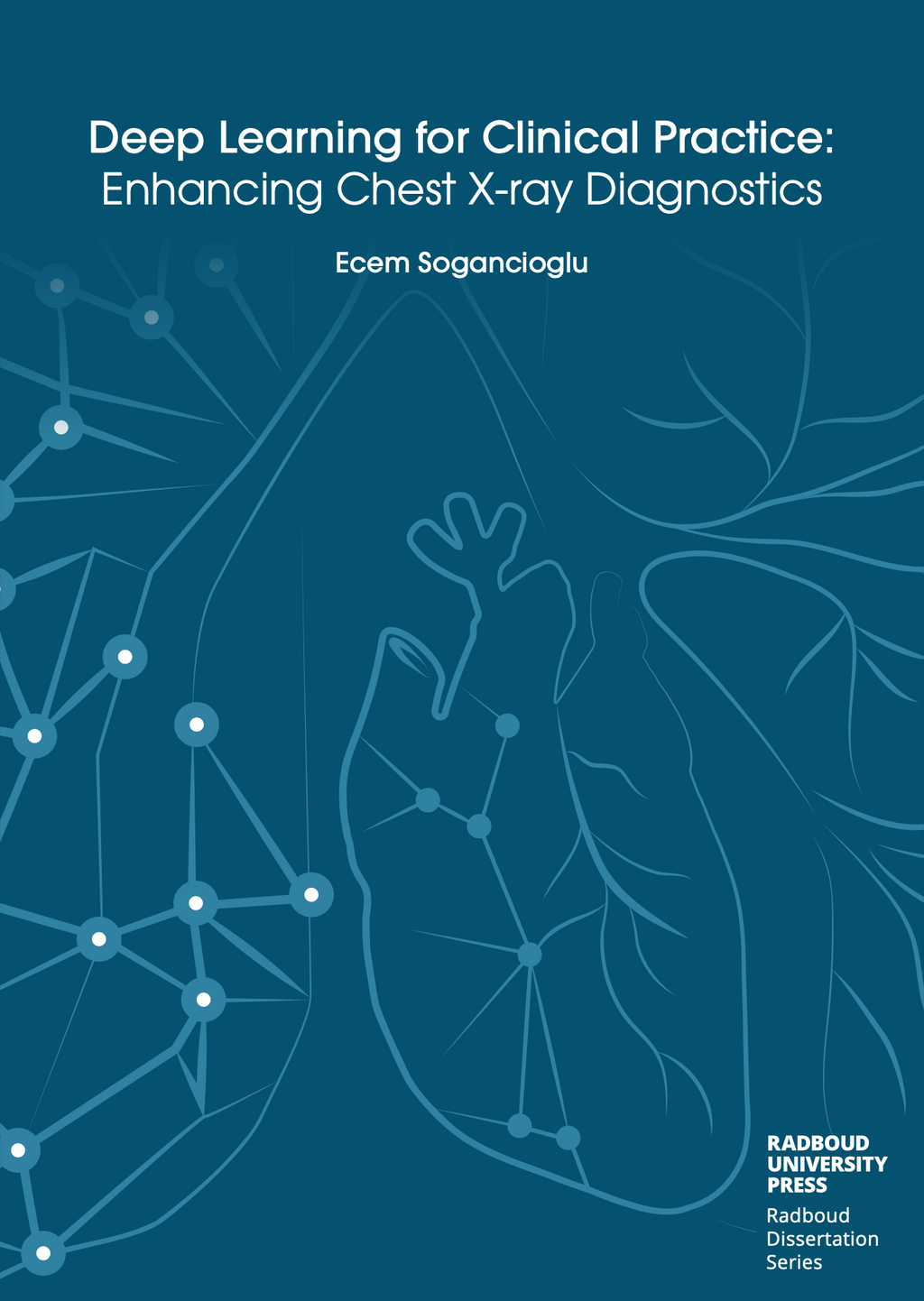Deep Learning for Clinical Practice: Enhancing Chest X-ray Diagnostics
E. Sogancioglu
- Promotor: B. van Ginneken and C. Gutierrez
- Copromotor: K. Murphy
- Graduation year: 2024
- Radboud University
Abstract
In Chapter 1, we lay the groundwork by introducing the core concepts on the basics of Chest X-rays (CXR), detailing their varieties and applications in medical practice. Subsequently, we address the challenges in CXR interpretation in clinical settings, establishing a case for the necessity of automated systems in CXR analysis. This chapter also offers a brief overview of the deep learning frameworks employed throughout the thesis and highlights the current gaps and hurdles identified in existing research. It equips readers with the essential knowledge needed to understand the field of CXR analysis and introduces the solutions proposed in this thesis to address these challenges.
Chapter 2 presents an extensive review of the literature on CXR analysis from 296 peer reviewed studies, pinpointing critical gaps and suggesting directions for future research. It introduces deep learning and CXR fundamentals, categorizes key literature trends by their analytical tasks, and provides a detailed overview of public datasets and commercial CXR analysis products. Serving as a pivotal resource, this analysis is designed not only to orient new researchers to the field but also to offer insights for researchers from other disciplines seeking to understand the nuances of CXR analysis through deep learning. The chapter reflects on the collective achievements and challenges faced by the CXR deep learning research community, discussing common pitfalls and suggesting directions for future work. By doing so, it lays the groundwork for developing CXR analysis methodologies with clear clinical applicability, thereby setting the stage for the research discussed in subsequent chapters.
In Chapter 3, we critically examine the prevalent use of classification-based methodologies in the literature for detecting cardiomegaly in chest X-rays (CXR) and introduce an alternative strategy centered on anatomical segmentation. This chapter performs a comparative analysis between these two distinct deep learning tasks, namely anatomical segmentation and image-level classification, employing systematic hyperparameter optimization to optimize their performance. Our findings indicate that the segmentation-based technique not only surpasses image-level classification in performance but also enhances interpretability substantially. The proposed approach, when trained on a dataset of moderate size comprising chest radiographs, achieves a comparable performance to the radiologist. Importantly, the model generates a quantitative measurement that is clinically relevant, offering a pathway to consistent and reproducible assessments, as well as facilitating detailed reporting. The model developed is publicly available.
Chapter 4 delves into the utilization of deep learning methodologies for the measurement of a critical quantitative biomarker: total lung volume, using chest X-ray (CXR) images. To our knowledge, this is one of the first studies illustrating the ability of state-of-the-art deep learning techniques to accurately estimate total lung volume from conventional chest radiographs. The study demonstrates a potential application towards expanding the diagnostic capabilities of CXR beyond traditional visual assessments. The model developed is openly accessible and can be employed to determine total lung volume from routinely captured chest X-rays. This deep learning system has potential to serve as a valuable instrument for tracking trends over time in patients who undergo regular chest X-ray examinations.
Chapter 5 examines state-of-the-art nodule detection and generation methodologies through the orchestration of an open-source and collaborative research initiative, NODE21. We organized a public research challenge, NODE21, with the objective of benchmarking state-of-the-art techniques in nodule detection and generation task on chest X-rays. We additionally performed extensive experiments using the top performing solutions from each track to analyze the impact of synthetic nodule generation methodologies for the task of nodule detection on CXR. Our results demonstrate that employing generated images can improve the performance of detection methods, with this impact being especially pronounced when there is a scarcity of real nodule images available. Furthermore, the structure of this challenge was designed to accept submissions exclusively in the form of open-source solutions using Docker containers, which guarantees the reproducibility of all methods submitted. The challenge also contributes to the field by providing a valuable public dataset, annotated by radiologists, to facilitate research and address this important clinical issue.
In Chapter 6, we reflect on the work presented in the previous chapters of this thesis. We examine the main contributions and applications of our research for CXR analysis. We further discuss potential future directions to move towards the development and integration of AI systems that can be effectively utilized in clinical settings.
